![]()
![]()
![]()
Use LEFT and RIGHT arrow keys to navigate between flashcards;
Use UP and DOWN arrow keys to flip the card;
H to show hint;
A reads text to speech;
57 Cards in this Set
- Front
- Back
|
Flies Life Cycle |
Adults mate; Females produce eggs; Eggs hatch and larvae emerge; Larvae develop and pupate; Adults emerge from pupae |
|
|
Flies Disease Models |
Adult acts as vectors while feeding; Allergies to bites; Trauma from bites; Damage from larval migration; Damage from larval development in the host tissues; Larvae feed off host tissues
|
|
|
Fly Categories |
Biting flies; Myaisis flies- facultative and obligatory;
|
|
|
Biting Flies |
Culicoides spp.; Sumulium spp.; Lutzomyia spp.; Culex spp.; Chrysops spp.; Tabanus spp.; Stomoxys calcitrans; Hematobia irritans |
|
|
Disease models of Biting Flies |
Adults act as disease vectors when they take a blood meal; Biting causes: irritation, interruption of grazing, affects production, and stampedes Can see allergic reactions to bites; Anemia from heavy infestations |
|
|
Culicoides spp. |
AKA no-see-ums, punkies, sand flies, and midges; Only 1-3 mm long; Inflict painful bites and suck blood of the host; Most active at dusk and dawn; Vector of blue-tongue virus in sheep; Causes sweet itch |
|
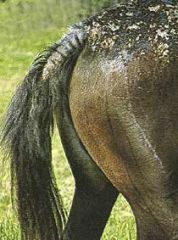
|
Sweet Itch; Allergy to the Culicoides spp. bites in horses; Causes intense pruritis around the tail and head; Signs and symptoms include alopecia and scabs; Difficult to prevent as the flies only need to bit the horse briefly to cause a reaction |
|
|
Simulium spp. |
AKA black flies; Very painful bites from scissor-like mouthparts; Most active during the day |
|
|
Lutzomyia spp. |
AKA sand flies; Tiny and moth-like; Most active at night |
|
|
Culex spp. |
AKA mosquitoes; Lay eggs on water; Intermediate host for D. immitis; Vector for malaria and yellow fever in humans |
|
|
Chrysops spp. and Tabanus spp. |
AKA Deerflies (chrysops) and horse flies (Tabanus) Larges fries in order Diptera; most active during the day; Large scissor-like mouthparts cause painful bites; Vectorfor anaplasmosis, anthrax, and equine infectious anemia |
|
|
Stomoxys calcitrans |
AKA stable fly or biting house fly; Avid blood feeders; Lay eggs in decaying organic material; Bayone-like mouthparts; Intermediate host for Habronema spp.; Vectors of antrax and equine infectious anemia |
|
|
Hematobia irritans |
AKA horn fly of cattle; Cluster around horns in lower temps; Lay eggs in cow feces; Bayonet-like mouthparts |
|
|
Myaisis Flies |
when fly larvae develop in host tissues; Two types- facultative and obligatory |
|
|
Falcultative Myaisis |
AKA fly strike Flies adapted from laying eggs in the carcasses to also using moist wounds, skin lesions, or soiled hair coats of alive hosts; Includes Musca spp. and bottle/blow flies; Eggs are laid by flies, larvae emerge (maggots) and eat dead tissues, larva also tunnel causing damage |
|
|
Musca spp. |
AKA house flies or face flies; "vomit drop feeders" |
|
|
Bottle/Blow Flies |
Includes a variety of species; "Vomit Drop Feeders"; Shiny and iridescent blue, green or black; Ressembles the colors of glass bottles |
|
|
Obligatory Myaisis Species |
Cuterebra spp.; Hypoderma spp.; Oestrus ovis; Gastrophilus spp. |
|
|
Obligatory Myaisis |
Flies need a host to complete its life cycle; Eggs are laid by flies, larvae penetrate and develop within living tissues, then drop to ground to pupate |
|
|
Cuterebra spp. |
AKA Warbles or Wolves; Larvae infest the skin of a variety of species including rodents and rabbits; Rarely infects humans |
|
|
Cuterebra spp L2 |
Cream to gray in color, sparsely-spined, 5-10mm long; Careful in larval removal - anaphylaxis
|
|
|
Cuterebra spp. L3 |
Black, heavily-spined, up to 3cm long; Careful in larval removal - anaphylaxis |
|
|
Cuterebra spp. Life Cycle |
Adults lay eggs near rodent holes; Larvae crawl onto host; Larvae migrate into tissues; Develops through 3 stages within tissues of the host; Erupts from tissues to pupate on the ground; Adult fly emerges from pupa |
|
|
Cuterebrosis |
Swollen cysts form at site of larvae; Central breathing pore for larvae to develop; Can see secondary infections at site of cysts; Symptoms from aberrant migration |
|
|
Hypoderma spp. |
AKA- for adults: gad flies or heel flies; for larvae: cattle grubs or ox warbles; Larvae found in tissues 2.5-3.0 cm long, covered with small spines, and are cream to dark brown in color; Careful with larval removal - anaphylaxis; Affects cattle but may infect horses, sheep and humans |
|
|
Hypoderma spp Life Cycle |
Adults (ressemble bees) lay eggs on hairs of cow leg; Larvae hatch and crawl down to penetrate the skin; Migrate to subcutaneous tissues in the back; Crawl out to pupate on the ground; Adult fly emerges; PPP: 12 months |
|
|
Hypoderma spp. Symptoms |
Adults quite agitating- gadding, poor grazing; Damage in areas of larval migration: spinal cord, esophagus, and muscles; Cysts along back with a central breathing pore; Secondary infection of cysts |
|
|
Oestrus ovis |
AKA nasal bots or nasal bot flies; Affects sheep/goats; ID fully formed larvae: 3 cm long, dark brown in color, large black oral hooks |
|
|
Oestrus ovis Life Cycle |
Adults (ressemble bees) deposits larvae into nostrils of sheep/goats; Tiny whitish larvae penetrate sinuses; Develops within sinuses; Fully developed larva drops to the ground; Pupates on the ground; Adult fly emerges |
|
|
Oestrs ovis Symptoms |
Variably seen with aberrant migration; Keeping head close to ground; Sinusitis; Purulent rhinitis |
|
|
Gasterophilus spp. |
AKA bot flies; Eggs seen on legs of horses- remove with bot knife; ID larvae in feces or stomach - barrel-shaped, brown in colour, up to 20mm long, dense spines on cranial boarder of each segment |
|
|
Gasterophilus spp. Life Cycle |
Adult (ressembles bees) lay eggs on fetlock, chin and shoulders (late summer); Horses groom and swallow the eggs; Larvae emerges and migrates to stomach; Larvae attach to cardiac portion of stomach (10-12 months); Larvae pass in feces to pupate on the ground; Adult flies emerge late summer |
|
|
Gasterophilus spp Symptoms |
Adult flies agitating; Large numbers can cause gastric ulcers- anemia, digested blood in feces, poor appetite, and digestion problems |
|
|
Melophagus ovinus |
AKA sheep ked or louse fly; Found deep in wool/fleece of sheep and goats; Louse-like appearance- wingless, hairy and leathery, strong claws, and are 4-7mm long |
|
|
Melophagus ovinus symptoms |
Wool becomes discolored from fecal matter; Highly pruritic- biting, scratching, rubbing, wool/fleece damage; Avid blood feeders- high infestations cause anemia |
|
|
Melophagus ovinus Life Cycle |
Male and female adult mate; Female produces 1 live larva at a time into wool/ fleece; Larvae pupate; Develops to adult; Adults most numerous in fall and winter |
|
|
Control Measures for Flies |
Repellants and insecticides; Removal of organic debris from grazing area; Keep animals away from standing water; House inside when flies most active; Cover affected areas to prevent fly access; Protect wounds and surgery sites; Keep haircoat clean and dry |
|
|
Order Diptera |
Flies; Adults have 1 pair of wings; Feed on blood, saliva, tear and/or mucus |
|
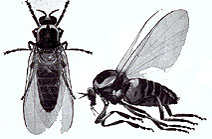
|
Simulium spp. |
|
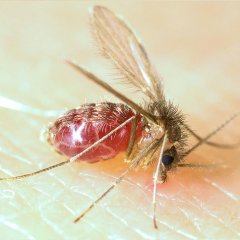
|
Lutzomyia spp. |
|
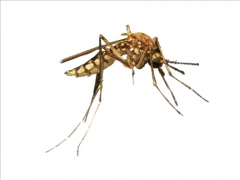
|
Culex spp. |
|
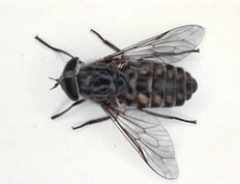
|
Chrysops spp. & Tabanus spp. |
|
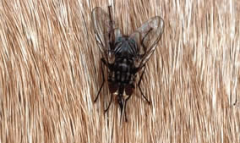
|
Stomoxys calcitrans |
|
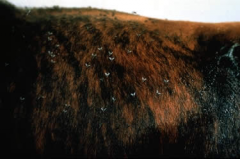
|
Hematobia irritans |
|
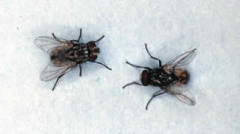
|
Musca spp. |
|
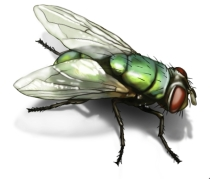
|
Bottle or Blow Flies |
|
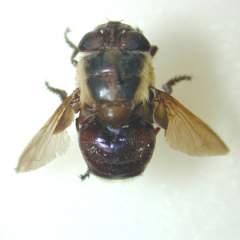
|
Cuterebra spp. |
|
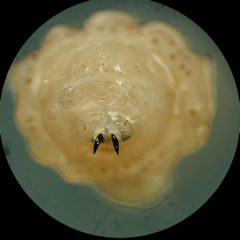
|
Cuterebra spp. L2 |
|
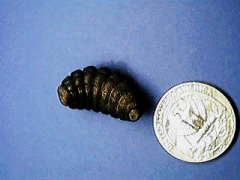
|
Cuterebra spp. L3 |
|

|
Cuterebrosis |
|
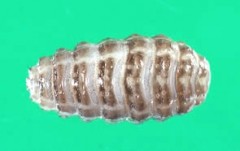
|
Hypoderma spp. |
|
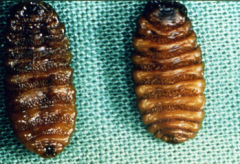
|
Oestrus ovis |
|
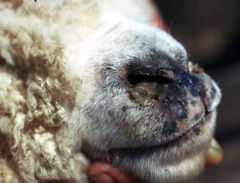
|
Oestrus ovis symptoms |
|
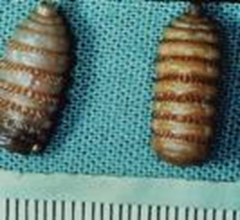
|
Gasterophilus spp. |
|
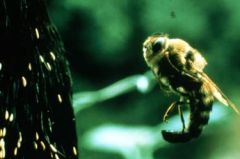
|
Gasterophilus spp. Ova |
|
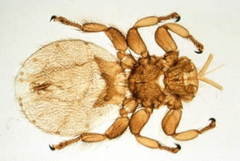
|
Melophagus ovinus |
|
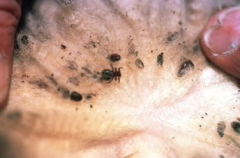
|
Melophagus ovinus Symptoms |

